Customer Switching Factors: Flow Trinidad Research Proposal
VerifiedAdded on 2022/08/11
|21
|4110
|42
Report
AI Summary
This research proposal investigates the factors affecting customer switching behavior at Flow Trinidad, a telecommunications company in Trinidad and Tobago. The study aims to explore the conceptual understanding of customer switching, identify the key factors influencing this behavior, and recommend strategies to improve customer retention. The research will employ a mixed-methods approach, combining both quantitative and qualitative data collection techniques. Data will be gathered through questionnaires and semi-structured interviews. The research design includes a descriptive case study and a cross-sectional study. The proposal outlines the research paradigm, philosophy, approach, and strategy, as well as detailed plans for data collection, analysis, and ethical considerations. The study's findings are expected to provide valuable insights into customer switching patterns and inform strategies for enhancing customer loyalty and retention within the telecommunications sector.

Anglia Ruskin University
" Customer Switching - A study of Flow Trinidad"
Student ID:
Module: Research Methods for Business and Management
Assessment: 011 Research Proposal
Code: MOD001105
Faculty: Lord Ashcroft International Business School
Lecturer: Andre Samuel
Date: xx May 2019
" Customer Switching - A study of Flow Trinidad"
Student ID:
Module: Research Methods for Business and Management
Assessment: 011 Research Proposal
Code: MOD001105
Faculty: Lord Ashcroft International Business School
Lecturer: Andre Samuel
Date: xx May 2019
Paraphrase This Document
Need a fresh take? Get an instant paraphrase of this document with our AI Paraphraser

Table of Contents
Chapter 1 Introduction.................................................................................................................................3
1.1 Introduction.................................................................................................................................3
1.2 Research Issue...................................................................................................................................3
1.3 Rationale............................................................................................................................................3
1.4 Research Question.............................................................................................................................4
1.5 Research Aim....................................................................................................................................4
1.6 Research Objectives..........................................................................................................................4
Chapter 2 Literature Review........................................................................................................................4
2.1 Introduction.................................................................................................................................4
2.2 Body............................................................................................................................................4
2.3 Summary.....................................................................................................................................5
Chapter 3 Research Design and Methodology.............................................................................................6
3.0 Introduction.......................................................................................................................................6
3.1 Research Paradigm............................................................................................................................7
3.1.1 Research Philosophy...................................................................................................................7
3.1.2 Research Approach.....................................................................................................................7
3.1.3 Research Strategy.......................................................................................................................8
3.2 Research Design................................................................................................................................8
3.3 Data Collection..................................................................................................................................9
3.3.1 Questionnaire..............................................................................................................................9
3.3.2 Interviews.................................................................................................................................10
3.3.3 Summary of Data Collection.....................................................................................................11
3.4 Data Analysis Plan...........................................................................................................................12
3.4.1 Quantitative Analysis................................................................................................................12
3.4.2 Qualitative Analysis..................................................................................................................12
3.5 Ethics...............................................................................................................................................13
3.6 Limitations to Research Methodology.............................................................................................15
3.7 Research Timetable.........................................................................................................................15
3.8 Conclusion.......................................................................................................................................17
Reference List...........................................................................................................................................18
2
Chapter 1 Introduction.................................................................................................................................3
1.1 Introduction.................................................................................................................................3
1.2 Research Issue...................................................................................................................................3
1.3 Rationale............................................................................................................................................3
1.4 Research Question.............................................................................................................................4
1.5 Research Aim....................................................................................................................................4
1.6 Research Objectives..........................................................................................................................4
Chapter 2 Literature Review........................................................................................................................4
2.1 Introduction.................................................................................................................................4
2.2 Body............................................................................................................................................4
2.3 Summary.....................................................................................................................................5
Chapter 3 Research Design and Methodology.............................................................................................6
3.0 Introduction.......................................................................................................................................6
3.1 Research Paradigm............................................................................................................................7
3.1.1 Research Philosophy...................................................................................................................7
3.1.2 Research Approach.....................................................................................................................7
3.1.3 Research Strategy.......................................................................................................................8
3.2 Research Design................................................................................................................................8
3.3 Data Collection..................................................................................................................................9
3.3.1 Questionnaire..............................................................................................................................9
3.3.2 Interviews.................................................................................................................................10
3.3.3 Summary of Data Collection.....................................................................................................11
3.4 Data Analysis Plan...........................................................................................................................12
3.4.1 Quantitative Analysis................................................................................................................12
3.4.2 Qualitative Analysis..................................................................................................................12
3.5 Ethics...............................................................................................................................................13
3.6 Limitations to Research Methodology.............................................................................................15
3.7 Research Timetable.........................................................................................................................15
3.8 Conclusion.......................................................................................................................................17
Reference List...........................................................................................................................................18
2
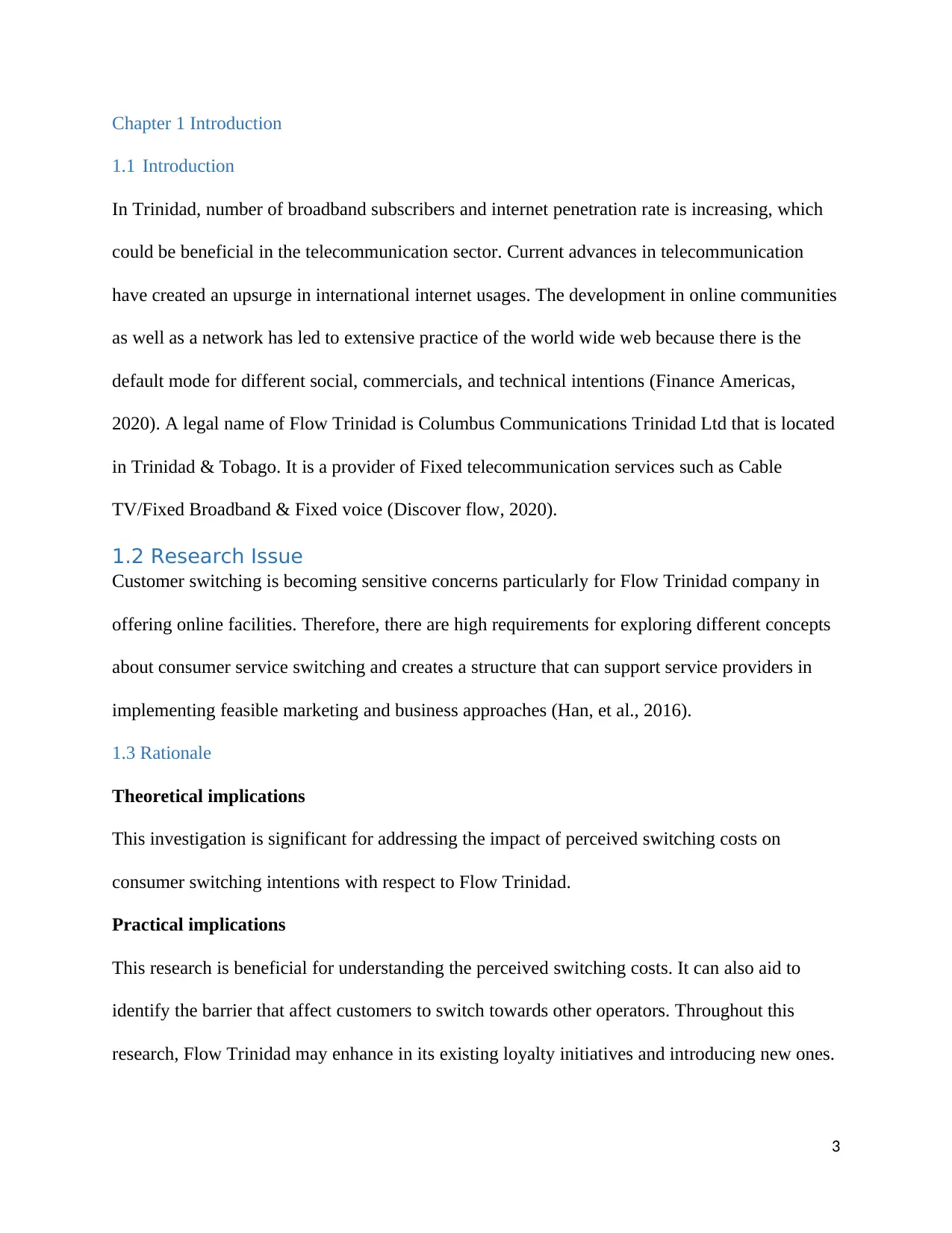
Chapter 1 Introduction
1.1 Introduction
In Trinidad, number of broadband subscribers and internet penetration rate is increasing, which
could be beneficial in the telecommunication sector. Current advances in telecommunication
have created an upsurge in international internet usages. The development in online communities
as well as a network has led to extensive practice of the world wide web because there is the
default mode for different social, commercials, and technical intentions (Finance Americas,
2020). A legal name of Flow Trinidad is Columbus Communications Trinidad Ltd that is located
in Trinidad & Tobago. It is a provider of Fixed telecommunication services such as Cable
TV/Fixed Broadband & Fixed voice (Discover flow, 2020).
1.2 Research Issue
Customer switching is becoming sensitive concerns particularly for Flow Trinidad company in
offering online facilities. Therefore, there are high requirements for exploring different concepts
about consumer service switching and creates a structure that can support service providers in
implementing feasible marketing and business approaches (Han, et al., 2016).
1.3 Rationale
Theoretical implications
This investigation is significant for addressing the impact of perceived switching costs on
consumer switching intentions with respect to Flow Trinidad.
Practical implications
This research is beneficial for understanding the perceived switching costs. It can also aid to
identify the barrier that affect customers to switch towards other operators. Throughout this
research, Flow Trinidad may enhance in its existing loyalty initiatives and introducing new ones.
3
1.1 Introduction
In Trinidad, number of broadband subscribers and internet penetration rate is increasing, which
could be beneficial in the telecommunication sector. Current advances in telecommunication
have created an upsurge in international internet usages. The development in online communities
as well as a network has led to extensive practice of the world wide web because there is the
default mode for different social, commercials, and technical intentions (Finance Americas,
2020). A legal name of Flow Trinidad is Columbus Communications Trinidad Ltd that is located
in Trinidad & Tobago. It is a provider of Fixed telecommunication services such as Cable
TV/Fixed Broadband & Fixed voice (Discover flow, 2020).
1.2 Research Issue
Customer switching is becoming sensitive concerns particularly for Flow Trinidad company in
offering online facilities. Therefore, there are high requirements for exploring different concepts
about consumer service switching and creates a structure that can support service providers in
implementing feasible marketing and business approaches (Han, et al., 2016).
1.3 Rationale
Theoretical implications
This investigation is significant for addressing the impact of perceived switching costs on
consumer switching intentions with respect to Flow Trinidad.
Practical implications
This research is beneficial for understanding the perceived switching costs. It can also aid to
identify the barrier that affect customers to switch towards other operators. Throughout this
research, Flow Trinidad may enhance in its existing loyalty initiatives and introducing new ones.
3
⊘ This is a preview!⊘
Do you want full access?
Subscribe today to unlock all pages.

Trusted by 1+ million students worldwide
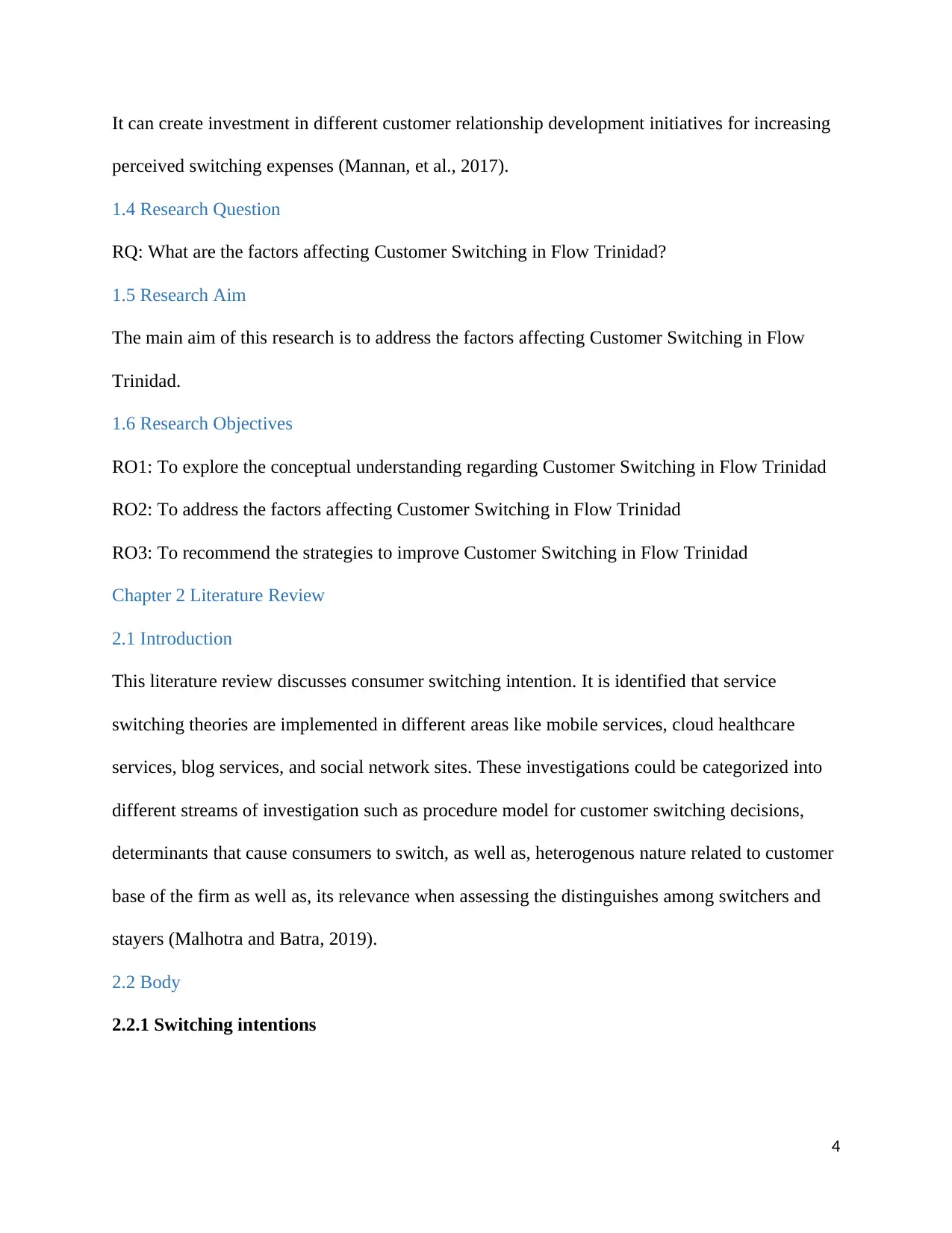
It can create investment in different customer relationship development initiatives for increasing
perceived switching expenses (Mannan, et al., 2017).
1.4 Research Question
RQ: What are the factors affecting Customer Switching in Flow Trinidad?
1.5 Research Aim
The main aim of this research is to address the factors affecting Customer Switching in Flow
Trinidad.
1.6 Research Objectives
RO1: To explore the conceptual understanding regarding Customer Switching in Flow Trinidad
RO2: To address the factors affecting Customer Switching in Flow Trinidad
RO3: To recommend the strategies to improve Customer Switching in Flow Trinidad
Chapter 2 Literature Review
2.1 Introduction
This literature review discusses consumer switching intention. It is identified that service
switching theories are implemented in different areas like mobile services, cloud healthcare
services, blog services, and social network sites. These investigations could be categorized into
different streams of investigation such as procedure model for customer switching decisions,
determinants that cause consumers to switch, as well as, heterogenous nature related to customer
base of the firm as well as, its relevance when assessing the distinguishes among switchers and
stayers (Malhotra and Batra, 2019).
2.2 Body
2.2.1 Switching intentions
4
perceived switching expenses (Mannan, et al., 2017).
1.4 Research Question
RQ: What are the factors affecting Customer Switching in Flow Trinidad?
1.5 Research Aim
The main aim of this research is to address the factors affecting Customer Switching in Flow
Trinidad.
1.6 Research Objectives
RO1: To explore the conceptual understanding regarding Customer Switching in Flow Trinidad
RO2: To address the factors affecting Customer Switching in Flow Trinidad
RO3: To recommend the strategies to improve Customer Switching in Flow Trinidad
Chapter 2 Literature Review
2.1 Introduction
This literature review discusses consumer switching intention. It is identified that service
switching theories are implemented in different areas like mobile services, cloud healthcare
services, blog services, and social network sites. These investigations could be categorized into
different streams of investigation such as procedure model for customer switching decisions,
determinants that cause consumers to switch, as well as, heterogenous nature related to customer
base of the firm as well as, its relevance when assessing the distinguishes among switchers and
stayers (Malhotra and Batra, 2019).
2.2 Body
2.2.1 Switching intentions
4
Paraphrase This Document
Need a fresh take? Get an instant paraphrase of this document with our AI Paraphraser

As per the opinion of Mahajan Misra and Mahajan (2017), customer tendencies to switch
towards other companies are illustrated as switching intentions. It is identified that a customer
who has a higher switching attitude is likely to switch, it is not an assurance that consumers
would switch in the near future. In addition to this, switching intention, brand switching as well
as, repurchase intentions are all closely associated with customer switching.
2.2.2 Perceived switching costs
On the other hand, Jang Kwak and Lee (2017) evaluated that under the service sector, perceived
switching expenses are illustrated as consumers’ perception and subjective assessment of costs
that are incurred in switching to another service provider. Along with this, financial and
economic switching expenses are financially and monetary quantifiable expenses that a
consumer incur in moving from current to new service offeror. Moreover, psychological and
relational switching expenses exist when comfort, affection, faith, and comprehension with
respect to service providers (Roy, et al., 2012). It develops a switching barrier for the consumer
through valuable associations.
2.3 Summary
5
Factors affecting
customer switching
Pricing
Inconvenience
Competition
Ethical issue
Care service and service
encounter failure
Customer
switching
Behaviour
Word of mouth
about customer
switching
Search for new services
towards other companies are illustrated as switching intentions. It is identified that a customer
who has a higher switching attitude is likely to switch, it is not an assurance that consumers
would switch in the near future. In addition to this, switching intention, brand switching as well
as, repurchase intentions are all closely associated with customer switching.
2.2.2 Perceived switching costs
On the other hand, Jang Kwak and Lee (2017) evaluated that under the service sector, perceived
switching expenses are illustrated as consumers’ perception and subjective assessment of costs
that are incurred in switching to another service provider. Along with this, financial and
economic switching expenses are financially and monetary quantifiable expenses that a
consumer incur in moving from current to new service offeror. Moreover, psychological and
relational switching expenses exist when comfort, affection, faith, and comprehension with
respect to service providers (Roy, et al., 2012). It develops a switching barrier for the consumer
through valuable associations.
2.3 Summary
5
Factors affecting
customer switching
Pricing
Inconvenience
Competition
Ethical issue
Care service and service
encounter failure
Customer
switching
Behaviour
Word of mouth
about customer
switching
Search for new services

Chapter 3 Research Design and Methodology
3.0 Introduction
A research design is significant for illustrating the structure of an investigation. Through research
design, an investigation can provide the right way to understand the investigation concern in
order to obtain significant and feasible information (Quinlan et al. 2019).
(Sources: Ali and Batai, 2020).
Under the Honeycomb of research methodology, different key aspects of the investigation are
joined with different other components in order to develop research methodology. There are
different elements of honeycomb. These are research approach, research philosophy, research
strategy, research design, data collection, as well as, data analysis tools come together in order to
develop research methodology (Basias and Pollalis, 2018).
6
3.0 Introduction
A research design is significant for illustrating the structure of an investigation. Through research
design, an investigation can provide the right way to understand the investigation concern in
order to obtain significant and feasible information (Quinlan et al. 2019).
(Sources: Ali and Batai, 2020).
Under the Honeycomb of research methodology, different key aspects of the investigation are
joined with different other components in order to develop research methodology. There are
different elements of honeycomb. These are research approach, research philosophy, research
strategy, research design, data collection, as well as, data analysis tools come together in order to
develop research methodology (Basias and Pollalis, 2018).
6
⊘ This is a preview!⊘
Do you want full access?
Subscribe today to unlock all pages.

Trusted by 1+ million students worldwide
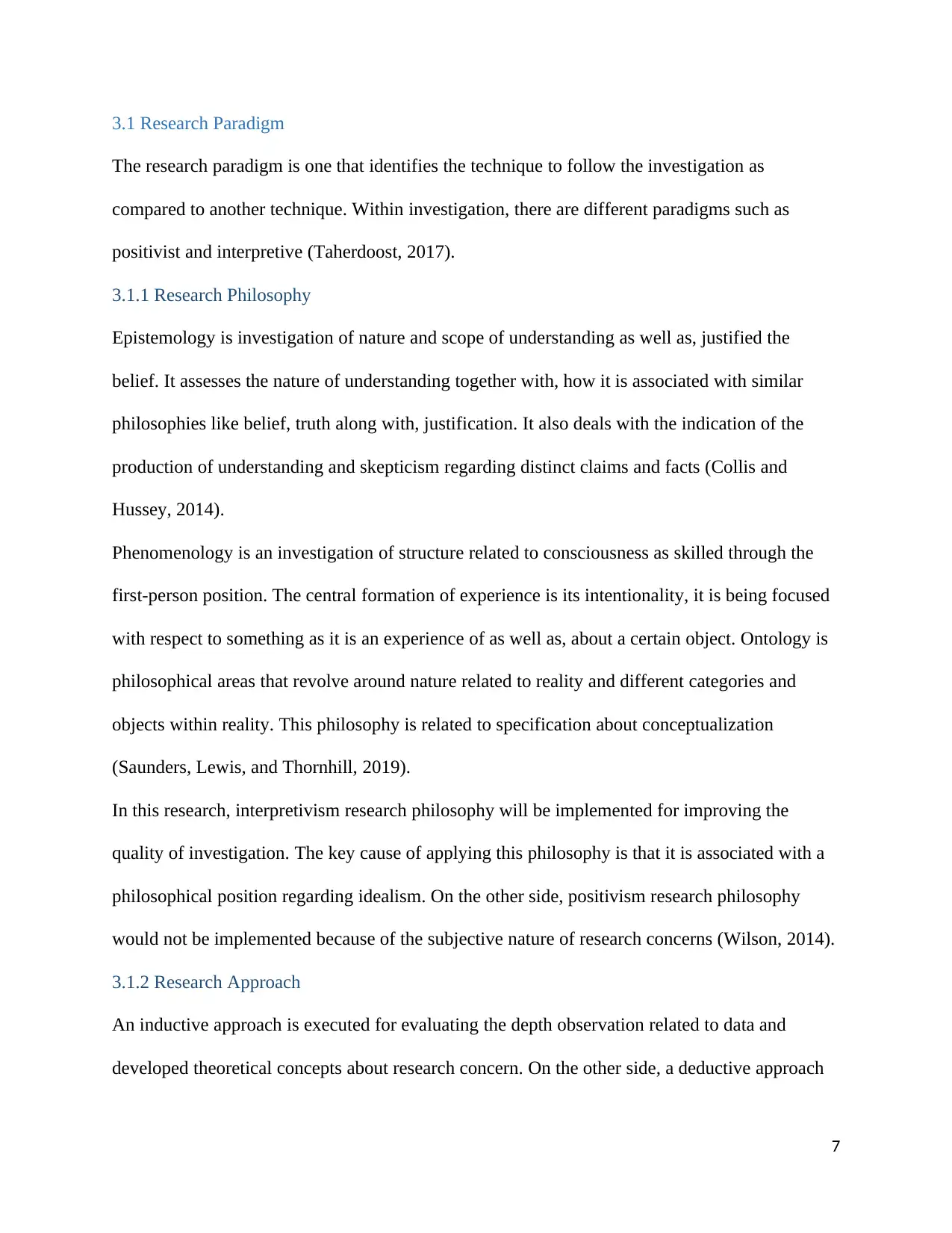
3.1 Research Paradigm
The research paradigm is one that identifies the technique to follow the investigation as
compared to another technique. Within investigation, there are different paradigms such as
positivist and interpretive (Taherdoost, 2017).
3.1.1 Research Philosophy
Epistemology is investigation of nature and scope of understanding as well as, justified the
belief. It assesses the nature of understanding together with, how it is associated with similar
philosophies like belief, truth along with, justification. It also deals with the indication of the
production of understanding and skepticism regarding distinct claims and facts (Collis and
Hussey, 2014).
Phenomenology is an investigation of structure related to consciousness as skilled through the
first-person position. The central formation of experience is its intentionality, it is being focused
with respect to something as it is an experience of as well as, about a certain object. Ontology is
philosophical areas that revolve around nature related to reality and different categories and
objects within reality. This philosophy is related to specification about conceptualization
(Saunders, Lewis, and Thornhill, 2019).
In this research, interpretivism research philosophy will be implemented for improving the
quality of investigation. The key cause of applying this philosophy is that it is associated with a
philosophical position regarding idealism. On the other side, positivism research philosophy
would not be implemented because of the subjective nature of research concerns (Wilson, 2014).
3.1.2 Research Approach
An inductive approach is executed for evaluating the depth observation related to data and
developed theoretical concepts about research concern. On the other side, a deductive approach
7
The research paradigm is one that identifies the technique to follow the investigation as
compared to another technique. Within investigation, there are different paradigms such as
positivist and interpretive (Taherdoost, 2017).
3.1.1 Research Philosophy
Epistemology is investigation of nature and scope of understanding as well as, justified the
belief. It assesses the nature of understanding together with, how it is associated with similar
philosophies like belief, truth along with, justification. It also deals with the indication of the
production of understanding and skepticism regarding distinct claims and facts (Collis and
Hussey, 2014).
Phenomenology is an investigation of structure related to consciousness as skilled through the
first-person position. The central formation of experience is its intentionality, it is being focused
with respect to something as it is an experience of as well as, about a certain object. Ontology is
philosophical areas that revolve around nature related to reality and different categories and
objects within reality. This philosophy is related to specification about conceptualization
(Saunders, Lewis, and Thornhill, 2019).
In this research, interpretivism research philosophy will be implemented for improving the
quality of investigation. The key cause of applying this philosophy is that it is associated with a
philosophical position regarding idealism. On the other side, positivism research philosophy
would not be implemented because of the subjective nature of research concerns (Wilson, 2014).
3.1.2 Research Approach
An inductive approach is executed for evaluating the depth observation related to data and
developed theoretical concepts about research concern. On the other side, a deductive approach
7
Paraphrase This Document
Need a fresh take? Get an instant paraphrase of this document with our AI Paraphraser

is executed for implementing the hypothesis. Through the development of the hypothesis, an
investigation could accept or reject the research process related to investigation concern (Hair, et
al., 2019).
In the context of this research, the inductive approach will be implemented by the investigator
because of the subjective nature of the investigation. There is no need for developing hypothesis
hence the inductive approach will be implemented and the deductive approach will not be
applied in this context (Zikmund, Carr, and Griffin, 2013).
3.1.3 Research Strategy
There are distinct kinds of research strategies that can be implemented in an investigation like
quantitative and qualitative research strategies. Along with this, quantitative research strategy
emphasizes collecting numerical data through statistical tools. Qualitative research strategy
makes competent an investigator for developing an opinion as well as, developing a hypothesis
(Eriksson and Kovalainen, 2015).
For this research strategy, an investigator would implement a mixed research strategy since it
would consider the features of both quantitative and qualitative research strategies. In such a
manner, a qualitative approach would make competent an investigator to create theoretical
information regarding “Customer Switching - A study of Flow Trinidad”. Along with this,
quantitative approach will be significant for providing statistical information related to the
investigation issue (Bell, Bryman, and Harley, 2018).
3.2 Research Design
In the context of this investigation, an investigator would use both interviews and survey through
questionnaires in order to obtain the information related to “Customer Switching - A study of
Flow Trinidad”. Through this research design, an investigator would be competent in gathering
8
investigation could accept or reject the research process related to investigation concern (Hair, et
al., 2019).
In the context of this research, the inductive approach will be implemented by the investigator
because of the subjective nature of the investigation. There is no need for developing hypothesis
hence the inductive approach will be implemented and the deductive approach will not be
applied in this context (Zikmund, Carr, and Griffin, 2013).
3.1.3 Research Strategy
There are distinct kinds of research strategies that can be implemented in an investigation like
quantitative and qualitative research strategies. Along with this, quantitative research strategy
emphasizes collecting numerical data through statistical tools. Qualitative research strategy
makes competent an investigator for developing an opinion as well as, developing a hypothesis
(Eriksson and Kovalainen, 2015).
For this research strategy, an investigator would implement a mixed research strategy since it
would consider the features of both quantitative and qualitative research strategies. In such a
manner, a qualitative approach would make competent an investigator to create theoretical
information regarding “Customer Switching - A study of Flow Trinidad”. Along with this,
quantitative approach will be significant for providing statistical information related to the
investigation issue (Bell, Bryman, and Harley, 2018).
3.2 Research Design
In the context of this investigation, an investigator would use both interviews and survey through
questionnaires in order to obtain the information related to “Customer Switching - A study of
Flow Trinidad”. Through this research design, an investigator would be competent in gathering
8

innovative and fresh information related to the research concerns. Along with this, a descriptive
case study would be implemented by an investigator in order to identify the cause and effect
association among research concerns. Furthermore, a cross-sectional study is an observational
study that considers the assessment of gathered data from population and representative subset at
one particular time period (Gray, 2019).
3.3 Data Collection
In the context of this research study, both data gathering tools would be implemented for
gathering the data related to “Customer Switching - A study of Flow Trinidad”. It will be
significant in order to create reliable and valid results. In such a manner, primary data would be
captured through conducting interviews and surveys through the questionnaire as well as,
secondary data would be captures via a literature review. Primary data will be implemented in
this research since it facilitates reliable data whereas secondary data will be implemented
because it will take minimum time period and cost in order to create the already published data
(Quinlan, et al., 2019).
3.3.1 Questionnaire
The following objective would be used to gather the information through survey questionnaire:
To address the factors affecting Customer Switching in Flow Trinidad
To recommend the strategies to improve Customer Switching in Flow Trinidad
Discuss clearly and in detail:
In this research study, probability sampling will be implemented by the investigator because of
subjective nature related to investigation concern. In such a context, a simple random sampling
method will be applied to select the participants since it reduces the probability of biased concern
from an investigation by choosing respondents on a random basis (Aithal, 2017). With the
9
case study would be implemented by an investigator in order to identify the cause and effect
association among research concerns. Furthermore, a cross-sectional study is an observational
study that considers the assessment of gathered data from population and representative subset at
one particular time period (Gray, 2019).
3.3 Data Collection
In the context of this research study, both data gathering tools would be implemented for
gathering the data related to “Customer Switching - A study of Flow Trinidad”. It will be
significant in order to create reliable and valid results. In such a manner, primary data would be
captured through conducting interviews and surveys through the questionnaire as well as,
secondary data would be captures via a literature review. Primary data will be implemented in
this research since it facilitates reliable data whereas secondary data will be implemented
because it will take minimum time period and cost in order to create the already published data
(Quinlan, et al., 2019).
3.3.1 Questionnaire
The following objective would be used to gather the information through survey questionnaire:
To address the factors affecting Customer Switching in Flow Trinidad
To recommend the strategies to improve Customer Switching in Flow Trinidad
Discuss clearly and in detail:
In this research study, probability sampling will be implemented by the investigator because of
subjective nature related to investigation concern. In such a context, a simple random sampling
method will be applied to select the participants since it reduces the probability of biased concern
from an investigation by choosing respondents on a random basis (Aithal, 2017). With the
9
⊘ This is a preview!⊘
Do you want full access?
Subscribe today to unlock all pages.

Trusted by 1+ million students worldwide
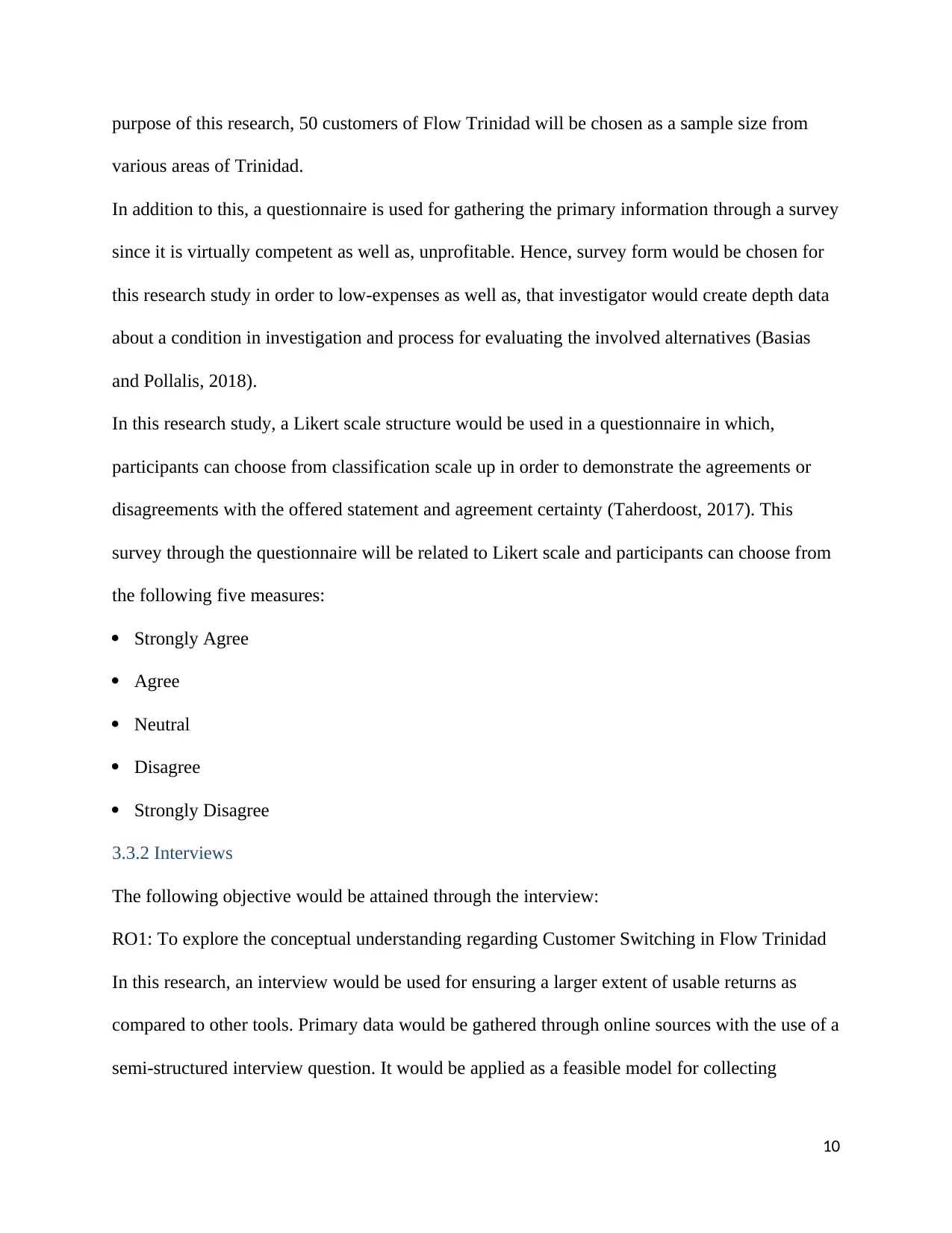
purpose of this research, 50 customers of Flow Trinidad will be chosen as a sample size from
various areas of Trinidad.
In addition to this, a questionnaire is used for gathering the primary information through a survey
since it is virtually competent as well as, unprofitable. Hence, survey form would be chosen for
this research study in order to low-expenses as well as, that investigator would create depth data
about a condition in investigation and process for evaluating the involved alternatives (Basias
and Pollalis, 2018).
In this research study, a Likert scale structure would be used in a questionnaire in which,
participants can choose from classification scale up in order to demonstrate the agreements or
disagreements with the offered statement and agreement certainty (Taherdoost, 2017). This
survey through the questionnaire will be related to Likert scale and participants can choose from
the following five measures:
Strongly Agree
Agree
Neutral
Disagree
Strongly Disagree
3.3.2 Interviews
The following objective would be attained through the interview:
RO1: To explore the conceptual understanding regarding Customer Switching in Flow Trinidad
In this research, an interview would be used for ensuring a larger extent of usable returns as
compared to other tools. Primary data would be gathered through online sources with the use of a
semi-structured interview question. It would be applied as a feasible model for collecting
10
various areas of Trinidad.
In addition to this, a questionnaire is used for gathering the primary information through a survey
since it is virtually competent as well as, unprofitable. Hence, survey form would be chosen for
this research study in order to low-expenses as well as, that investigator would create depth data
about a condition in investigation and process for evaluating the involved alternatives (Basias
and Pollalis, 2018).
In this research study, a Likert scale structure would be used in a questionnaire in which,
participants can choose from classification scale up in order to demonstrate the agreements or
disagreements with the offered statement and agreement certainty (Taherdoost, 2017). This
survey through the questionnaire will be related to Likert scale and participants can choose from
the following five measures:
Strongly Agree
Agree
Neutral
Disagree
Strongly Disagree
3.3.2 Interviews
The following objective would be attained through the interview:
RO1: To explore the conceptual understanding regarding Customer Switching in Flow Trinidad
In this research, an interview would be used for ensuring a larger extent of usable returns as
compared to other tools. Primary data would be gathered through online sources with the use of a
semi-structured interview question. It would be applied as a feasible model for collecting
10
Paraphrase This Document
Need a fresh take? Get an instant paraphrase of this document with our AI Paraphraser
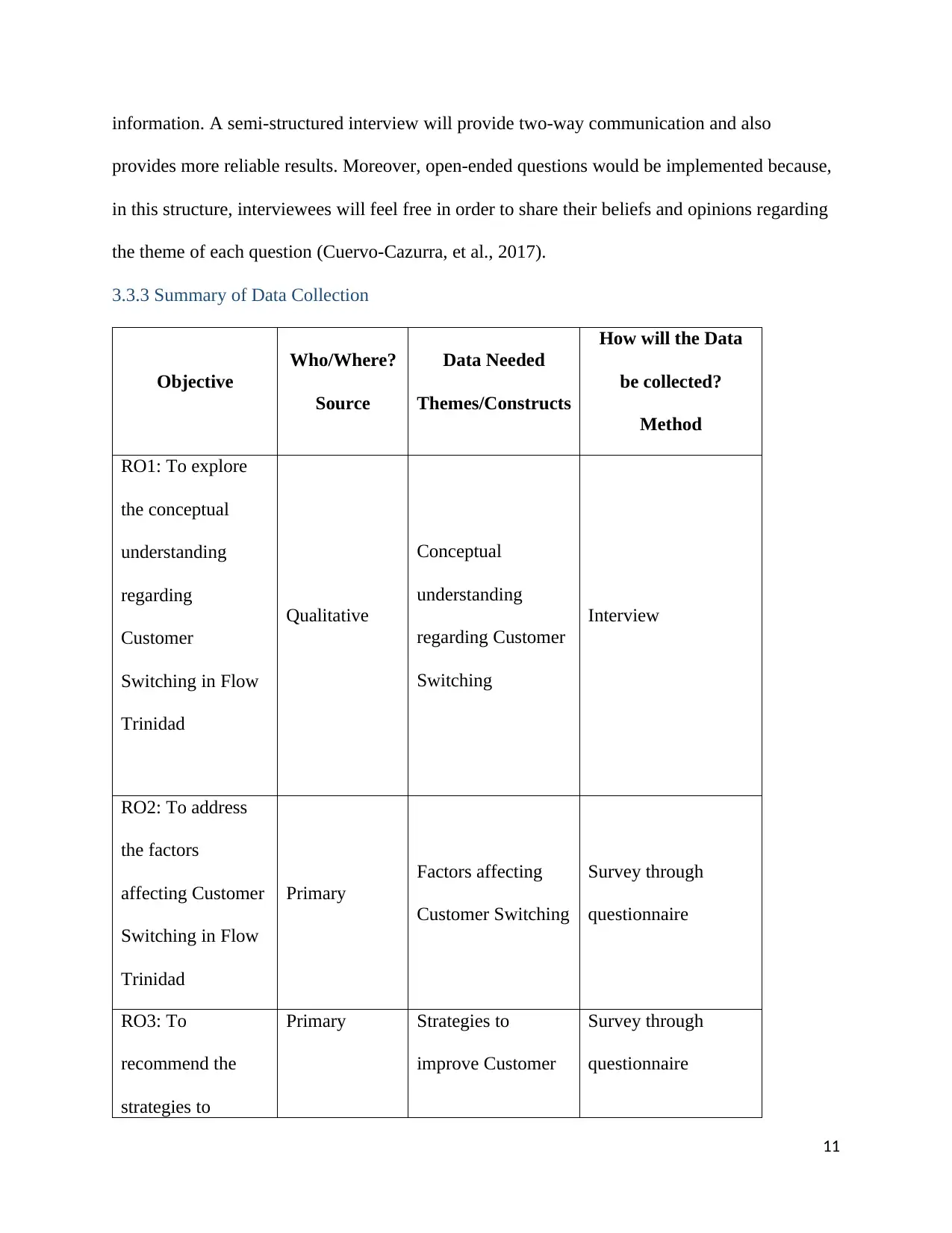
information. A semi-structured interview will provide two-way communication and also
provides more reliable results. Moreover, open-ended questions would be implemented because,
in this structure, interviewees will feel free in order to share their beliefs and opinions regarding
the theme of each question (Cuervo‐Cazurra, et al., 2017).
3.3.3 Summary of Data Collection
Objective
Who/Where?
Source
Data Needed
Themes/Constructs
How will the Data
be collected?
Method
RO1: To explore
the conceptual
understanding
regarding
Customer
Switching in Flow
Trinidad
Qualitative
Conceptual
understanding
regarding Customer
Switching
Interview
RO2: To address
the factors
affecting Customer
Switching in Flow
Trinidad
Primary
Factors affecting
Customer Switching
Survey through
questionnaire
RO3: To
recommend the
strategies to
Primary Strategies to
improve Customer
Survey through
questionnaire
11
provides more reliable results. Moreover, open-ended questions would be implemented because,
in this structure, interviewees will feel free in order to share their beliefs and opinions regarding
the theme of each question (Cuervo‐Cazurra, et al., 2017).
3.3.3 Summary of Data Collection
Objective
Who/Where?
Source
Data Needed
Themes/Constructs
How will the Data
be collected?
Method
RO1: To explore
the conceptual
understanding
regarding
Customer
Switching in Flow
Trinidad
Qualitative
Conceptual
understanding
regarding Customer
Switching
Interview
RO2: To address
the factors
affecting Customer
Switching in Flow
Trinidad
Primary
Factors affecting
Customer Switching
Survey through
questionnaire
RO3: To
recommend the
strategies to
Primary Strategies to
improve Customer
Survey through
questionnaire
11
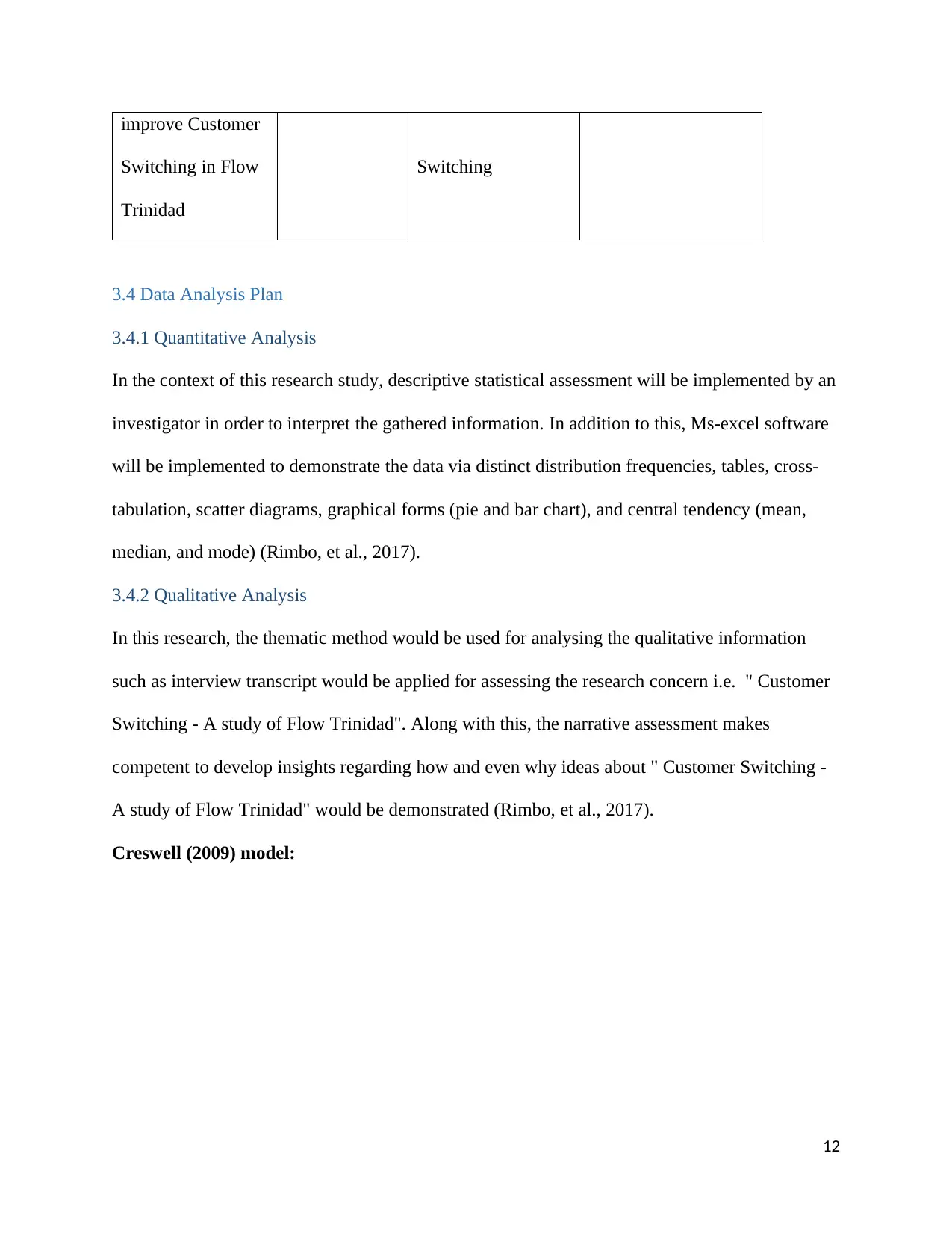
improve Customer
Switching in Flow
Trinidad
Switching
3.4 Data Analysis Plan
3.4.1 Quantitative Analysis
In the context of this research study, descriptive statistical assessment will be implemented by an
investigator in order to interpret the gathered information. In addition to this, Ms-excel software
will be implemented to demonstrate the data via distinct distribution frequencies, tables, cross-
tabulation, scatter diagrams, graphical forms (pie and bar chart), and central tendency (mean,
median, and mode) (Rimbo, et al., 2017).
3.4.2 Qualitative Analysis
In this research, the thematic method would be used for analysing the qualitative information
such as interview transcript would be applied for assessing the research concern i.e. " Customer
Switching - A study of Flow Trinidad". Along with this, the narrative assessment makes
competent to develop insights regarding how and even why ideas about " Customer Switching -
A study of Flow Trinidad" would be demonstrated (Rimbo, et al., 2017).
Creswell (2009) model:
12
Switching in Flow
Trinidad
Switching
3.4 Data Analysis Plan
3.4.1 Quantitative Analysis
In the context of this research study, descriptive statistical assessment will be implemented by an
investigator in order to interpret the gathered information. In addition to this, Ms-excel software
will be implemented to demonstrate the data via distinct distribution frequencies, tables, cross-
tabulation, scatter diagrams, graphical forms (pie and bar chart), and central tendency (mean,
median, and mode) (Rimbo, et al., 2017).
3.4.2 Qualitative Analysis
In this research, the thematic method would be used for analysing the qualitative information
such as interview transcript would be applied for assessing the research concern i.e. " Customer
Switching - A study of Flow Trinidad". Along with this, the narrative assessment makes
competent to develop insights regarding how and even why ideas about " Customer Switching -
A study of Flow Trinidad" would be demonstrated (Rimbo, et al., 2017).
Creswell (2009) model:
12
⊘ This is a preview!⊘
Do you want full access?
Subscribe today to unlock all pages.

Trusted by 1+ million students worldwide
1 out of 21
Related Documents
Your All-in-One AI-Powered Toolkit for Academic Success.
+13062052269
info@desklib.com
Available 24*7 on WhatsApp / Email
![[object Object]](/_next/static/media/star-bottom.7253800d.svg)
Unlock your academic potential
Copyright © 2020–2025 A2Z Services. All Rights Reserved. Developed and managed by ZUCOL.





